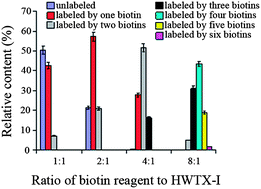Biotin labeling and receptor analysis of huwentoxin-I
Abstract
Huwentoxin-I (HWTX-I) is the highest content peptidic neurotoxin in the crude venom of spider Selenocosmia huwena. This toxin blocks the nerve–muscle conduction of isolated phrenic nerve–hemidiaphragm preparation reversibly, with the action site in the presynaptic membrane. In order to further investigate the action mechanism of HWTX-I, the present work optimized the experimental conditions for the biotin labeling of HWTX-I and used the site-selectively biotinylated toxin to affinity purify and identify its receptor proteins from the plasma membrane in rat phrenic nerve–diaphragm synapses. The experiments demonstrated that when the biotinylation reagent reacted with HWTX-I at a molar ratio of 2 : 1 on ice for 2 h, most HWTX-I molecules were labeled by a single biotin group, with a yield of 57%. Tandem mass spectrometry and electrophysiological experiments indicated that the single biotin labeling occurred at the Lys13 residue of HWTX-I and this biotinylation did not significantly affect the bioactivity of HWTX-I. After the affinity purified protein fraction was ultrafiltered, digested with trypsin and analyzed by CapLC-MS/MS, several membrane proteins including voltage-gated calcium channel proteins that HWTX-I potentially interacted with were identified and their roles in the action mechanism of HWTX-I were discussed.


 Please wait while we load your content...
Please wait while we load your content...